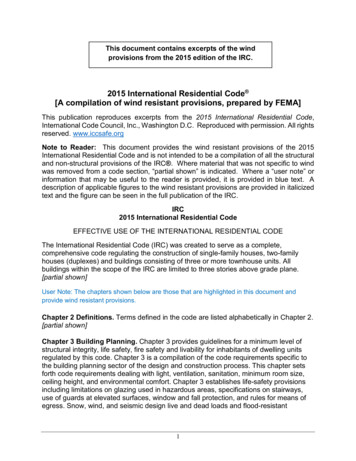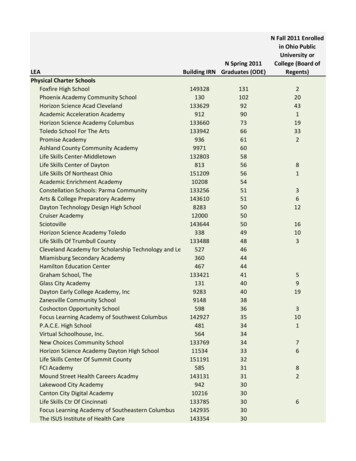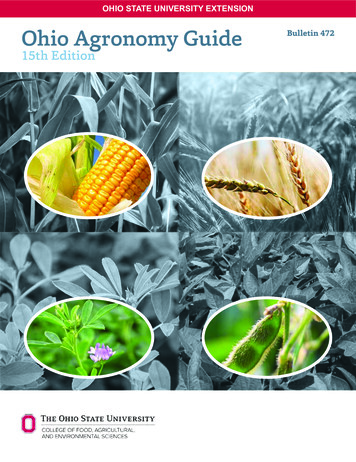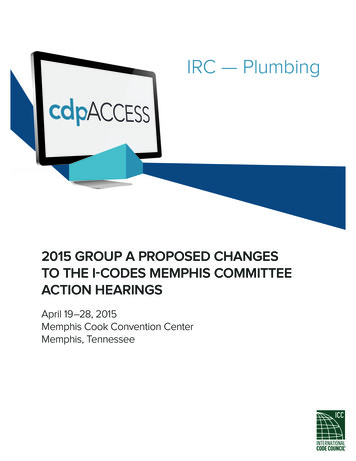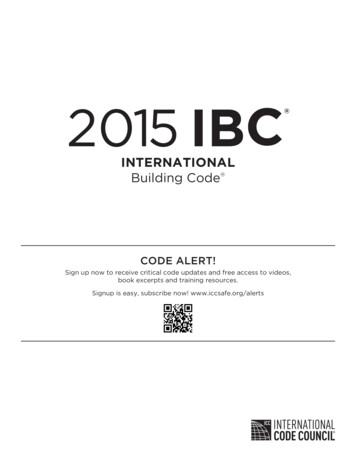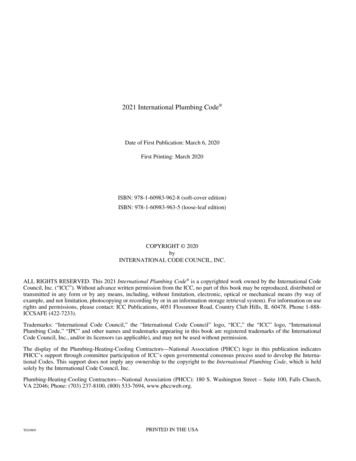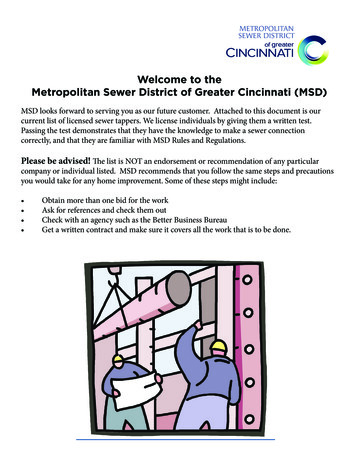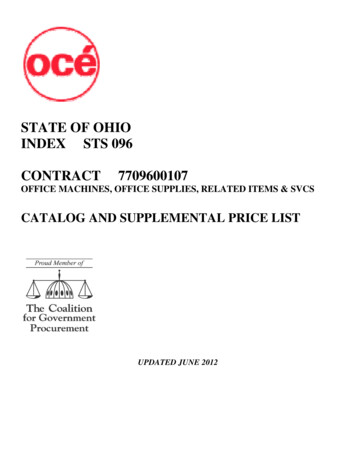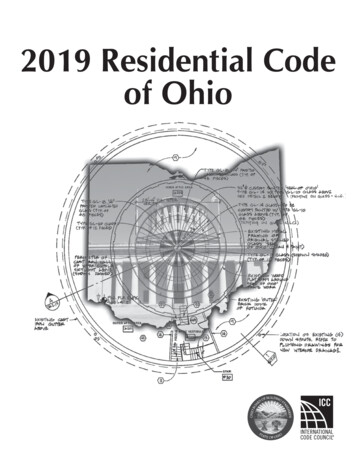
Transcription
2019 Residential Codeof Ohio
2019 Residential Code of OhioFirst Printing: May 2019ISBN: 978-1-60983-905-5COPYRIGHT 2019byINTERNATIONAL CODE COUNCIL, INC.ALL RIGHTS RESERVED. This 2019 Residential Code of Ohio contains substantial copyrighted material from the 2018 International Residential Code , first printing, which is a copyrighted work owned by the International Code Council, Inc. Withoutadvance written permission from the copyright owner, no part of this book may be reproduced, distributed or transmitted in anyform or by any means, including, without limitation, electronic, optical or mechanical means (by way of example, and not limitation, photocopying or recording by or in an information storage retrieval system). For information on use rights and permissions, please contact: ICC Publications, 4051 Flossmoor Road, Country Club Hills, IL 60478. Phone 1-888-ICC-SAFE (4227233).Trademarks: “International Code Council,” the “International Code Council” logo, “ICC,” the “ICC” logo, “International Residential Code,” “IRC” and other names and trademarks appearing in this book are registered trademarks of the International CodeCouncil, Inc., and/or its licensors (as applicable), and may not be used without permission.Cover Design Credits: The publishers would like to acknowledge the assistance of the Capitol Square Review and AdvisoryBoard and Schooley Caldwell Associates in collecting information on the Ohio Statehouse that made the development of thecovers for this code edition possible.T023966PRINTED IN THE USA
PREFACEIntroductionOhio code users please note that the 2019 Residential Code of Ohio for 1-, 2-, and 3-Family Dwellings is based on the 2018 International Residential Code. This code establishes minimum requirements for one-, two-, and three-family dwellings using prescriptive provisions. It is founded onbroad-based principles that make possible the use of new materials and new building designs. This2018 edition is fully compatible with all of the International Codes (I-Codes ) published by theInternational Code Council (ICC ), including the International Building Code , InternationalEnergy Conservation Code , International Existing Building Code , International Fire Code , International Fuel Gas Code , International Green Construction Code , International Mechanical Code ,International Plumbing Code , International Private Sewage Disposal Code , International PropertyMaintenance Code , International Swimming Pool and Spa Code , International Wildland-UrbanInterface Code , International Zoning Code and International Code Council Performance Code .The I-Codes, including this International Residential Code, are used in a variety of ways in boththe public and private sectors. Most industry professionals are familiar with the I-Codes as the basisof laws and regulations in communities across the U.S. and in other countries. Ohio uses the modelcodes as the basis for uniform minimum requirements, as modified, for enforcement throughoutthe state.In addition to the codes themselves, the code development process brings together building professionals on a regular basis. It provides an international forum for discussion and deliberationabout building design, construction methods, safety, performance requirements, technologicaladvances and innovative products.DevelopmentThis 2018 edition presents the code as originally issued, with changes reflected in the 2003 through2015 editions and further changes approved by the ICC Code Development Process through 2017.Residential electrical provisions are based on the 2017 National Electrical Code (NFPA 70). A newedition such as this is promulgated every 3 years.Fuel gas provisions have been included through an agreement with the American Gas Association (AGA). Electrical provisions have been included through an agreement with the National FireProtection Association (NFPA).This code is founded on principles intended to establish provisions consistent with the scope of aresidential code that adequately protects public health, safety and welfare; provisions that do notunnecessarily increase construction costs; provisions that do not restrict the use of new materials,products or methods of construction; and provisions that do not give preferential treatment to particular types or classes of materials, products or methods of construction.MaintenanceThe International Residential Code is kept up-to-date through the review of proposed changes submitted by code enforcement officials, industry representatives, design professionals and otherinterested parties. Proposed changes are carefully considered through an open code developmentprocess in which all interested and affected parties may participate.The contents of this work are subject to change through the code development cycles and by anygovernmental entity that enacts the code into law. For more information regarding the code development process, contact the Codes and Standards Development Department of the InternationalCode Council.2019 RESIDENTIAL CODE OF OHIOiii
While the I-Code development procedure is thorough and comprehensive, the ICC, its membersand those participating in the development of the codes disclaim any liability resulting from thepublication or use of the I-Codes, or from compliance or noncompliance with their provisions. TheICC does not have the power or authority to police or enforce compliance with the contents of thiscode.Marginal MarkingsItalicized text indicates Ohio specific language.AdoptionSee Section 101 General. The effective date of this code throughout Ohio is July 1, 2019.iv2019 RESIDENTIAL CODE OF OHIO
EFFECTIVE USE OF THE RESIDENTIAL CODEEffective Use of the Residential Code of OhioThe Residential Code of Ohio (RCO) was created to serve as a complete, comprehensive code regulating the construction of single-family houses, two-family houses (duplexes) and three-familyhouses. All buildings within the scope of the RCO are limited to three stories above grade plane. Forexample, a four-story single-family house would fall within the scope of the Building Code (BC), notthe RCO. The benefits of devoting a separate code to residential construction include the fact thatthe user need not navigate through a multitude of code provisions that do not apply to residentialconstruction in order to locate that which is applicable. A separate code also allows for residentialand nonresidential code provisions to be distinct and tailored to the structures that fall within theappropriate code’s scopes.The RCO contains coverage for all components of a house or townhouse, including structuralcomponents, fireplaces and chimneys, thermal insulation, mechanical systems, fuel gas systems,plumbing systems and electrical systems.The RCO is a prescriptive-oriented (specification) code with some examples of performance codelanguage. It has been said that the RCO is the complete cookbook for residential construction. Section 301.1, for example, is written in performance language, but states that the prescriptive requirements of the code will achieve such performance.It is important to understand that the RCO contains coverage for what is conventional and common in residential construction practice. While the RCO will provide all of the needed coverage formost residential construction, it might not address construction practices and systems that areatypical or rarely encountered in the industry. Sections such as 301.1.3, 301.2.2.1.1, 320.1, 1301.1,2401.1 and 2601.1 refer to other codes either as an alternative to the provisions of the RCO orwhere the RCO lacks coverage for a particular type of structure, design, system, appliance ormethod of construction. In other words, the RCO is meant to be all inclusive for typical residentialconstruction and it relies on other codes only where alternatives are desired or where the codelacks coverage for the uncommon aspect of residential construction. Of course, the RCO constantlyevolves to address new technologies and construction practices that were once uncommon, but arenow common.The RCO is unique in that much of it, including Chapters 3 through 9 is presented in an orderedformat that is consistent with the normal progression of construction, starting with the designphase and continuing through the final trim-out phase. This is consistent with the “cookbook” philosophy of the RCO.The RCO is divided into eight main parts, specifically: Part I—Administration; Part II—Definitions;Part III—Building Planning and Construction; Part IV—Energy Conservation; Part V—Mechanical;Part VI—Fuel Gas; Part VII—Plumbing; and Part VIII—Electrical.The following provides a brief description of the content of each chapter of the RCO:Chapter 1 Administration. This chapter contains provisions for the application, enforcementand administration of subsequent requirements of the code. In addition to establishing the scope ofthe code, Chapter 1 identifies which buildings and structures come under its purview. Chapter 1 islargely concerned with maintaining “due process of law” in enforcing the building criteria containedin the body of the code. Only through careful observation of the administrative provisions can thebuilding official reasonably expect to demonstrate that “equal protection under the law” has beenprovided.Chapter 2 Definitions. Terms defined in the code are listed alphabetically in Chapter 2.Where understanding a term’s definition is key to or necessary for understanding a particularcode provision, the term is shown in italics where it appears in the code. This is true only for thoseterms that have a meaning that is unique to the code. In other words, the generally understoodmeaning of a term or phrase might not be sufficient or consistent with the meaning prescribed bythe code; therefore, it is essential that the code-defined meaning be known.2019 RESIDENTIAL CODE OF OHIOv
Guidance regarding not only tense, gender and plurality of defined terms, but also terms notdefined in this code, is provided.Chapter 3 Building Planning. Chapter 3 provides guidelines for a minimum level of structuralintegrity, life safety, fire safety and livability for inhabitants of dwelling units regulated by this code.Chapter 3 is a compilation of the code requirements specific to the building planning sector of thedesign and construction process. This chapter sets forth code requirements dealing with light, ventilation, sanitation, minimum room size, ceiling height and environmental comfort. Chapter 3 establishes life-safety provisions including limitations on glazing used in hazardous areas, specificationson stairways, use of guards at elevated surfaces, window and fall protection, and rules for means ofegress. Snow, wind and seismic design live and dead loads and flood-resistant construction, as wellas solar energy systems, and swimming pools, spas and hot tubs, are addressed in this chapter.Chapter 4 Foundations. Chapter 4 provides the requirements for the design and construction offoundation systems for buildings regulated by this code. Provisions for seismic load, flood load andfrost protection are contained in this chapter. A foundation system consists of two interdependentcomponents: the foundation structure itself and the supporting soil.The prescriptive provisions of this chapter provide requirements for constructing footings andwalls for foundations of wood, masonry, concrete and precast concrete. In addition to a foundation's ability to support the required design loads, this chapter addresses several other factors thatcan affect foundation performance. These include controlling surface water and subsurface drainage, requiring soil tests where conditions warrant and evaluating proximity to slopes and minimumdepth requirements. The chapter also provides requirements to minimize adverse effects of moisture, decay and pests in basements and crawl spaces.Chapter 5 Floors. Chapter 5 provides the requirements for the design and construction of floorsystems that will be capable of supporting minimum required design loads. This chapter covers fourdifferent types: wood floor framing, wood floors on the ground, cold-formed steel floor framing andconcrete slabs on the ground. Allowable span tables are provided that greatly simplify the determination of joist, girder and sheathing sizes for raised floor systems of wood framing and cold-formedsteel framing. This chapter also contains prescriptive requirements for wood-framed exterior decksand their attachment to the main building.Chapter 6 Wall Construction. Chapter 6 contains provisions that regulate the design and construction of walls. The wall construction covered in Chapter 6 consists of five different types: woodframed, cold-formed steel framed, masonry, concrete and structural insulated panel (SIP). The primary concern of this chapter is the structural integrity of wall construction and transfer of allimposed loads to the supporting structure. This chapter provides the requirements for the designand construction of wall systems that are capable of supporting the minimum design vertical loads(dead, live and snow loads) and lateral loads (wind or seismic loads). This chapter contains the prescriptive requirements for wall bracing and/or shear walls to resist the imposed lateral loads due towind and seismic.Chapter 6 also regulates exterior windows and doors installed in walls. This chapter contains criteria for the performance of exterior windows and doors and includes provisions for testing andlabeling, garage doors, wind-borne debris protection and anchorage details.Chapter 7 Wall Covering. Chapter 7 contains provisions for the design and construction of interior and exterior wall coverings. This chapter establishes the various types of materials, materialsstandards and methods of application permitted for use as interior coverings, including interiorplaster, gypsum board, ceramic tile, wood veneer paneling, hardboard paneling, wood shakes andwood shingles. Chapter 7 also contains requirements for the use of vapor retarders for moisturecontrol in walls.Exterior wall coverings provide the weather-resistant exterior envelope that protects the building’s interior from the elements. Chapter 7 provides the requirements for wind resistance andwater-resistive barrier for exterior wall coverings. This chapter prescribes the exterior wall coverings as well as the water-resistive barrier required beneath the exterior materials. Exterior wall coverings regulated by this section include aluminum, stone and masonry veneer, wood, hardboard,particleboard, wood structural panel siding, wood shakes and shingles, exterior plaster, steel, vinyl,fiber cement and exterior insulation finish systems.vi2019 RESIDENTIAL CODE OF OHIO
Chapter 8 Roof-ceiling Construction. Chapter 8 regulates the design and construction of roofceiling systems. This chapter contains two roof-ceiling framing systems: wood framing and coldformed steel framing. Allowable span tables are provided to simplify the selection of rafter and ceiling joist size for wood roof framing and cold-formed steel framing. Chapter 8 also provides requirements for the application of ceiling finishes, the proper ventilation of concealed spaces in roofs(e.g., enclosed attics and rafter spaces), unvented attic assemblies and attic access.Chapter 9 Roof Assemblies. Chapter 9 regulates the design and construction of roof assemblies. A roof assembly includes the roof deck, vapor retarder, substrate or thermal barrier, insulation, vapor retarder and roof covering. This chapter provides the requirement for wind resistance ofroof coverings.The types of roof covering materials and installation regulated by Chapter 9 are: asphalt shingles,clay and concrete tile, metal roof shingles, mineral-surfaced roll roofing, slate and slate-type shingles, wood shakes and shingles, built-up roofs, metal roof panels, modified bitumen roofing, thermoset and thermoplastic single-ply roofing, sprayed polyurethane foam roofing, liquid appliedcoatings and photovoltaic shingles. Chapter 9 also provides requirements for roof drainage, flashing, above deck thermal insulation, rooftop-mounted photovoltaic systems and recovering orreplacing an existing roof covering.Chapter 10 Chimneys and Fireplaces. Chapter 10 contains requirements for the safe con-struction of masonry chimneys and fireplaces and establishes the standards for the use and installation of factory-built chimneys, fireplaces and masonry heaters. Chimneys and fireplaces constructedof masonry rely on prescriptive requirements for the details of their construction; the factory-builttype relies on the listing and labeling method of approval. Chapter 10 provides the requirements forseismic reinforcing and anchorage of masonry fireplaces and chimneys.Chapter 11 Energy Efficiency. The purpose of Chapter 11 is to provide minimum design requirements that will promote efficient utilization of energy in buildings. The requirements are directedtoward the design of building envelopes with adequate thermal resistance and low air leakage, andtoward the design and selection of mechanical, water heating, electrical and illumination systemsthat promote effective use of depletable energy resources. The provisions of Chapter 11 are duplicated from the International Energy Conservation Code—Residential Provisions, as applicable forbuildings which fall under the scope of the RCO.Chapter 12 Mechanical Administration. Chapter 12 establishes the limits of applicability ofthe code and describes how the code is to be applied and enforced. A mechanical code, like anyother code, is intended to be adopted as a legally enforceable document and it cannot be effectivewithout adequate provisions for its administration and enforcement. The provisions of Chapter 12establish the authority and duties of the code official appointed by the jurisdiction having authorityand also establish the rights and privileges of the design professional, contractor and propertyowner. It also relates this chapter to the administrative provisions in Chapter 1.Chapter 13 General Mechanical System Requirements. Chapter 13 contains broadly applicable requirements related to appliance listing and labeling, appliance location and installation,appliance and systems access, protection of structural elements and clearances to combustibles,among others.Chapter 14 Heating and Cooling Equipment and Appliances. Chapter 14 is a collection ofrequirements for various heating and cooling appliances, dedicated to single topics by section. Thecommon theme is that all of these types of appliances use energy in one form or another, and theimproper installation of such appliances would present a hazard to the occupants of the dwellings,due to either the potential for fire or the accidental release of refrigerants. Both situations areundesirable in dwellings that are covered by this code.Chapter 15 Exhaust Systems. Chapter 15 is a compilation of code requirements related to resi-dential exhaust systems, including kitchens and bathrooms, clothes dryers and range hoods. Thecode regulates the materials used for constructing and installing such duct systems. Air brought intothe building for ventilation, combustion or makeup purposes is protected from contamination by2019 RESIDENTIAL CODE OF OHIOvii
the provisions found in this chapter.Chapter 16 Duct Systems. Chapter 16 provides requirements for the installation of ducts forsupply, return and exhaust air systems. This chapter contains no information on the design of thesesystems from the standpoint of air movement, but is concerned with the structural integrity of thesystems and the overall impact of the systems on the fire-safety performance of the building. Thischapter regulates the materials and methods of construction which affect the performance of theentire air distribution system.Chapter 17 Combustion Air. Complete combustion of solid and liquid fuel is essential for theproper operation of appliances, control of harmful emissions and achieving maximum fuel efficiency. If insufficient quantities of oxygen are supplied, the combustion process will be incomplete,creating dangerous byproducts and wasting energy in the form of unburned fuel (hydrocarbons).The byproducts of incomplete combustion are poisonous, corrosive and combustible, and can causeserious appliance or equipment malfunctions that pose fire or explosion hazards.The combustion air provisions in this code from previous editions have been deleted from Chapter 17 in favor of a single section that directs the user to NFPA 31 for oil-fired appliance combustionair requirements and the manufacturer's installation instructions for solid fuel-burning appliances. Iffuel gas appliances are used, the provisions of Chapter 24 must be followed.Chapter 18 Chimneys and Vents. Chapter 18 regulates the design, construction, installation,maintenance, repair and approval of chimneys, vents and their connections to fuel-burning appliances. A properly designed chimney or vent system is needed to conduct the flue gases produced bya fuel-burning appliance to the outdoors. The provisions of this chapter are intended to minimizethe hazards associated with high temperatures and potentially toxic and corrosive combustiongases. This chapter addresses factory-built and masonry chimneys, vents and venting systems usedto vent oil-fired and solid fuel-burning appliances.Chapter 19 Special Appliances, Equipment and Systems. Chapter 19 regulates the installation of fuel-burning appliances that are not covered in other chapters, such as ranges and ovens,sauna heaters, fuel cell power plants and hydrogen systems. Because the subjects in this chapter donot contain the volume of text necessary to warrant individual chapters, they have been combinedinto a single chapter. The only commonality is that the subjects use energy to perform some task orfunction. The intent is to provide a reasonable level of protection for the occupants of the dwelling.Chapter 20 Boilers and Water Heaters. Chapter 20 regulates the installation of boilers andwater heaters. Its purpose is to protect the occupants of the dwelling from the potential hazardsassociated with such appliances. A water heater is any appliance that heats potable water and supplies it to the plumbing hot water distribution system. A boiler either heats water or generatessteam for space heating and is generally a closed system.Chapter 21 Hydronic Piping. Hydronic piping includes piping, fittings and valves used in buildingspace conditioning systems. Applications include hot water, chilled water, steam, steam condensate, brines and water/antifreeze mixtures. Chapter 21 regulates installation, alteration and repairof all hydronic piping systems to ensure the reliability, serviceability, energy efficiency and safety ofsuch systems.Chapter 22 Special Piping and Storage Systems. Chapter 22 regulates the design and installation of fuel oil storage and piping systems. The regulations include reference to construction standards for above-ground and underground storage tanks, material standards for piping systems(both above-ground and underground) and extensive requirements for the proper assembly of system piping and components. The purpose of this chapter is to prevent fires, leaks and spills involving fuel oil storage and piping systems, whether inside or outside structures and above orunderground.Chapter 23 Solar Thermal Energy Systems. Chapter 23 contains requirements for the construction, alteration and repair of all systems and components of solar thermal energy systems usedfor space heating or cooling, and domestic hot water heating or processing. The provisions of thischapter are limited to those necessary to achieve installations that are relatively hazard free.viii2019 RESIDENTIAL CODE OF OHIO
A solar thermal energy system can be designed to handle 100 percent of the energy load of abuilding, although this is rarely accomplished. Because solar energy is a low-intensity energy sourceand dependent on the weather, it is usually necessary to supplement a solar thermal energy systemwith traditional energy sources.As our world strives to find alternate means of producing power for the future, the requirementsof this chapter will become more and more important over time.Chapter 24 Fuel Gas. Chapter 24 regulates the design and installation of fuel gas distributionpiping and systems, appliances, appliance venting systems and combustion air provisions. The definition of “Fuel gas” includes natural, liquefied petroleum and manufactured gases and mixtures ofthese gases.The purposes of this chapter are to establish the minimum acceptable level of safety and to protect life and property from the potential dangers associated with the storage, distribution and useof fuel gases and the byproducts of combustion of such fuels. This code also protects the personnelwho install, maintain, service and replace the systems and appliances addressed herein.Chapter 24 is composed of text extracted from the IFGC.Chapter 25 Plumbing Systems. Requires compliance with the Ohio Plumbing Code referencedin Chapter 44 as modified by Chapter 25.Chapter 29 Water Supply and Distribution. This chapter remains solely for the purpose ofproviding another fire sprinkler option.Chapter 34 Electrical. This chapter requires compliance with the National Electric Code, NFPA70, referenced in Chapter 44 and as modified by Chapter 34.Chapter 44 Referenced Standards. The code contains numerous references to standards thatare used to regulate materials and methods of construction. Chapter 44 contains a comprehensivelist of all standards that are referenced in the code. The standards are part of the code to the extentof the reference to the standard. Compliance with the referenced standard is necessary for compliance with this code. By providing specifically adopted standards, the construction and installationrequirements necessary for compliance with the code can be readily determined. The basis for codecompliance is, therefore, established and available on an equal basis to the code official, contractor,designer and owner.Chapter 44 is organized in a manner that makes it easy to locate specific standards. It lists all ofthe referenced standards, alphabetically, by acronym of the promulgating agency of the standard.Each agency’s standards are then listed in either alphabetical or numeric order based upon the standard identification. The list also contains the title of the standard; the edition (date) of the standardreferenced; any addenda included as part of the ICC adoption; and the section or sections of thiscode that reference the standard.2019 RESIDENTIAL CODE OF OHIOix
x2019 RESIDENTIAL CODE OF OHIO
TABLE OF CONTENTSPart I—Administration . . . . . . . . . . . . . . . . . . . . . . . . . . . . 1309Garages and Carports. . . . . . . . . . . . . . . . . . . . . . . . 71310Emergency Escape and Rescue Openings . . . . . . . . 72CHAPTER 1 ADMINISTRATION . . . . . . . . . . . . . . . . 1311Means of Egress. . . . . . . . . . . . . . . . . . . . . . . . . . . . 73Section312Guards and Window Fall Protection . . . . . . . . . . . . 76101General . . . . . . . . . . . . . . . . . . . . . . . . . . . . . . . . . . . . 1313Automatic Fire Sprinkler Systems . . . . . . . . . . . . . . 77102Applicability and Jurisdictional Authority . . . . . . . . . 3314Smoke Alarms . . . . . . . . . . . . . . . . . . . . . . . . . . . . . 78103Certified Residential Building Departments,Personnel, and Appeals Boards . . . . . . . . . . . . . . . 6315Carbon Monoxide Alarms . . . . . . . . . . . . . . . . . . . . 79104Duties and Responsibilities . . . . . . . . . . . . . . . . . . . . 6316Foam Plastic. . . . . . . . . . . . . . . . . . . . . . . . . . . . . . . 79105Approvals . . . . . . . . . . . . . . . . . . . . . . . . . . . . . . . . . . 7317Protection of Wood and Wood-basedProducts against Decay . . . . . . . . . . . . . . . . . . . . 81106Construction Documents . . . . . . . . . . . . . . . . . . . . . . 8318Protection against Subterranean Termites . . . . . . . . 83107Plan Approval Process . . . . . . . . . . . . . . . . . . . . . . . 11319Site Address . . . . . . . . . . . . . . . . . . . . . . . . . . . . . . . 83108Inspection Process . . . . . . . . . . . . . . . . . . . . . . . . . . 12320Accessibility. . . . . . . . . . . . . . . . . . . . . . . . . . . . . . . 83109Orders, Violations, and Unsafe Buildings . . . . . . . . 15321Elevators and Platform Lifts . . . . . . . . . . . . . . . . . . 85110Appeals. . . . . . . . . . . . . . . . . . . . . . . . . . . . . . . . . . . 16322Flood-resistant Construction . . . . . . . . . . . . . . . . . . 85111Certificate of Occupancy andCertificate of Completion . . . . . . . . . . . . . . . . . . . 16323Storm Shelters . . . . . . . . . . . . . . . . . . . . . . . . . . . . . 88112Changes to the Code. . . . . . . . . . . . . . . . . . . . . . . . . 17113Existing Buildings and Structures . . . . . . . . . . . . . . 17114Products and Materials . . . . . . . . . . . . . . . . . . . . . . . 18115Board Organization . . . . . . . . . . . . . . . . . . . . . . . . . 21324Solar Energy Systems . . . . . . . . . . . . . . . . . . . . . . . 89325Mezzanines . . . . . . . . . . . . . . . . . . . . . . . . . . . . . . . 90326Swimming Pools, Spas and Hot Tubs . . . . . . . . . . . 90327Stationary Storage Battery Systems. . . . . . . . . . . . . 90328Post Frame Accessory Structures. . . . . . . . . . . . . . . 90Part II—Definitions. . . . . . . . . . . . . . . . . . . . . . . . . . . . . . 23CHAPTER 4 FOUNDATIONS. . . . . . . . . . . . . . . . . . . 95CHAPTER 2 DEFINITIONS . . . . . . . . . . . . . . . . . . . . 23SectionSection401General. . . . . . . . . . . . . . . . . . . . . . . . . . . . . . . . . . . 95201General . . . . . . . . . . . . . . . . . . . . . . . . . . . . . . . . . . . 23402Materials . . . . . . . . . . . . . . . . . . . . . . . . . . . . . .
Jul 01, 2019 · mon in residential construction practice. While the RCO will provide all of the needed coverage for most residential construction, it might not address construction practices and systems that are atypical or rarely encountered in the indust

